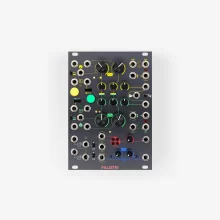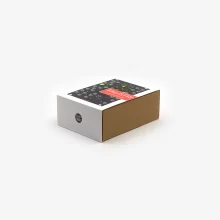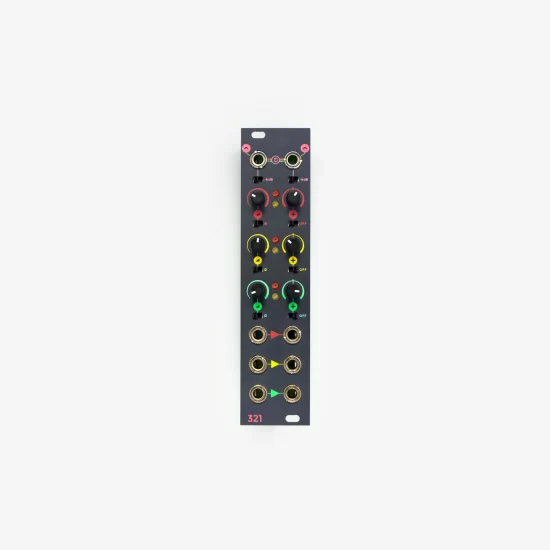Falistri
Movement Manager
falistri / faˈlistri / s.f., plural [Modenese dialect, probably from Latin fauilla, ‘spark’] – ‘sparks’. One cannot think about a lively bonfire without sparks crackling and dancing through the air. ‘Falistri’ is what lights up your patch and takes care of how it moves, through sparks, motions, and crackles.
OR:
390,00 € + VAT
In stock
Description
The FALISTRI is a fully analog multipurpose movement manager designed to generate and edit voltages to easily accomplish any patch.
The module can be divided into two big parts: in the upper two-thirds of the panel take place two specular function generators, while the lower third is composed of a dual cascaded frequency divider, a linear slew limiter, and a four-quadrant multiplier.
Key Features
We designed the generators to quickly and intuitively achieve the function needed.
The two generators are identical: they have the same controls and the same output set.
The Time Scale Switch lets you quickly swap from LFO to oscillator – and it tracks pretty well!
You can freely morph from Logarithmic to Linear to Exponential shapes without changing the time needed to complete Rise or Fall.
When you use FALISTRI as a modulator, it means that you can change the shape without changing the duration of your envelope or LFO.
When you use it as an oscillator, it means that you can change the waveform without changing the frequency!
You can have a Logarithmic Rise and Logarithmic Fall, Linear Attack and Logarithmic Fall, or any other combination of the three modes.
You can always blend between these shapes and achieve complex shapes both when generating CVs and audio signals.
Interacting with your patch is essential for us so that you can fire the envelopes both through an external trig/gate or the built-in buttons.
You can also use it to override the incoming gates and hold the envelope high for dramatic effects – it’s all about the performance!
Each function can work in three ways:
- Loop – The envelope retrigs itself, becoming an LFO or an oscillator.
- Transient – An attack-release envelope, with no sustain and no gate information.
- Sustained – An attack-hold-release envelope whose duration depends on the gate length.
You can automatically Switch from either Transient or Sustained to Loop through a gate input.
Connect the two sections for complex envelopes or waveforms!
With the Quadrature mode:
- The end of the yellow ‘Rise’ triggers the start of the green ‘Rise’;
- The end of the green ‘Rise’ triggers the start of the yellow ‘Fall’;
- The end of yellow ‘Fall’ triggers the start of green ‘Fall.’
Use it at audio rate to obtain a sort of trapezoid oscillator!
Each generator has five outputs:
- unipolar 0V/+10V;
- bipolar -5V/+5V;
- attenuverted -10V/0/+10V;
- End of Rise Gate
- End of Fall Gate
An additional Max output works as an analog OR, outputting the highest voltage currently generated by the two envelopes. It can create complex envelopes (like in Quadrature mode) or weird waveforms.
FALISTRI has two semi-normalled frequency dividers (or flip-flops).
Patch a gate signal to the first input obtain two gate streams of half and a quarter of its frequency. It works great with random clocks!
Use it with audio-rate signals to generate sub octaves.
You can patch two separate signals and use the frequency dividers independently.
This circuit works as a “bipolar DC-coupled linear VCA.” You can do:
- AM;
- RM;
- Voltage processing and scaling.
By default, it is semi-normalled to the green bipolar output and the yellow unipolar output, allowing you to use FALISTRI as a stand-alone synth voice.
A dedicated slew limiter allows you to smooth any voltage transition.
Create the classic portamento/glide effect, or get creative and experiment with the independent controls for the rise and fall stages.
You can even use it as a rudimentary third AR envelope!
Learn
Learn
Learn
Additional information
| Weight | 0,365 kg |
|---|---|
| Dimensions | 15,6 × 11,7 × 6 cm |
Specs
Size | 18 HP |
Depth | 38 mm |
Current draw | 170 mA @ +12 V 170 mA @ -12 V |
Recommended warmup time | 30 min |
CV input impedance | > 90 KΩ |
Trig/Gate input impedance | > 90 KΩ |
Input trigger amplitude threshold (Trig/Gate input) | > 1.5 V |
Input trigger maximum frequency at 1.5 V (Trig/Gate input) | > 6 KHz |
Input trigger minimum pulse period at 1.5 V (Trig/Gate input) | < 80 μs |
Force Loop input impedance | > 50 KΩ |
Input trigger amplitude threshold (Force Loop input) | > 3 V |
Input trigger maximum frequency at 3 V (Force Loop input) | > 6 KHz |
Input trigger minimum pulse period at 3 V (Force Loop input) | < 80 μs |
Single stage (Rise or Fall) with long times | From ~ 0.9 ms to ~ 10 s |
Complete cycle with long times | From ~ 1.9 ms to ~ 20 s From ~ 520 Hz to ~ 0.05 Hz |
Complete cycle with short times | From ~ 0.16 ms to ~ 1.5 s From ~ 6.1 KHz to ~ 0.67 Hz |
Generator voltage output unipolar amplitude | > 10 V |
Generator voltage output bipolar amplitude | > ±5 V |
Generator voltage output unipolar offset (in Rest stage) | < 35 mV |
Generator voltage output impedance | > 100 Ω |
Waveshapers amplitude tolerance (e.g. overshoot) | < 1 % |
Generator V/oct tracking tolerance (audible range) | < ±5 ȼ |
MAX output impedance | > 100 Ω |
MAX output amplitude | > 10 V |
Generator gate output offset | ± 20 mV |
Generator EOF output minimum positive pulse period | 1 ms |
Generator gate outputs impedance | > 220 Ω |
Generator gate outputs amplitude | > 3 V |
Frequency divider input maximum trigger frequency (at 3V) | 40 KHz |
Frequency divider minimum input pulse period | < 10 μs |
Frequency divider unipolar output amplitude | ~ 9.5 V |
Frequency divider bipolar output amplitude | > ±4.5 V |
Frequency divider output offset | < 50 to < 100 mV |
Frequency divider input impedance | > 90 KΩ |
Frequency divider output impedance | > 220 Ω |
4QM dynamic range | ~ 78 dB |
4QM residual THD+N | ~ 0.015 |
4QM maximum allowable gain | ~ 6.5 dB |
4QM high frequency roll-off | 36 KHz |
4QM input impedance | > 90 KΩ |
4QM output impedance | > 100 Ω |
Slew Limiter minimum slew rate | 1 to 1.25 V/ms |
Slew Limiter maximum slew rate | ~ 0.6 V/s |
Slew limiter input impedance | > 28 KΩ |
Slew limiter output impedance | > 100 Ω |
More details on the Manualone.
FAQ
C. Shop
Yes! We opened our online store in October 2022. Check out the full catalog!
Our resellers receive our modules exclusively through our distributor, so we do not have access to the individual shops’ orders or stocks.
We restock every module at least once over a year: we focus on a module’s batch at a time, then we move on to the next one, and so on.
If you want an estimated delivery time for a specific module, drop us a line! We’ll be happy to answer you.











